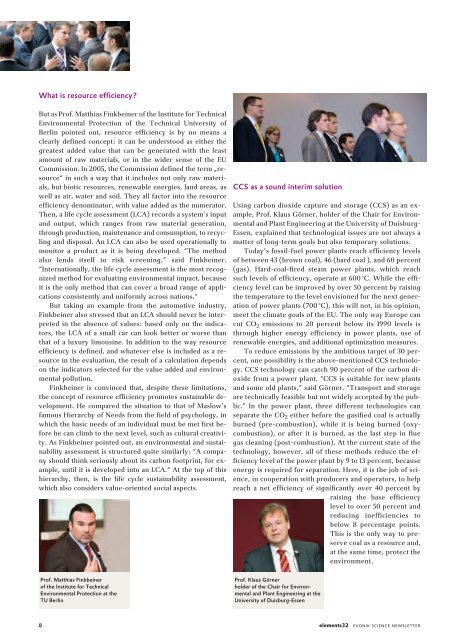Download - Evonik Industries
Download - Evonik Industries
Download - Evonik Industries
Create successful ePaper yourself
Turn your PDF publications into a flip-book with our unique Google optimized e-Paper software.
What is resource efficiency?<br />
But as Prof. Matthias Finkbeiner of the Institute for Technical<br />
Environmental Protection of the Technical University of<br />
Ber lin pointed out, resource efficiency is by no means a<br />
clearly defined concept: it can be understood as either the<br />
greatest added value that can be generated with the least<br />
amount of raw materials, or in the wider sense of the EU<br />
Commission. In 2005, the Commission defined the term „resource“<br />
in such a way that it includes not only raw materials,<br />
but biotic resources, renewable energies, land areas, as<br />
well as air, water and soil. They all factor into the resource<br />
efficiency denominator, with value added as the numerator.<br />
Then, a life cycle assessment (LCA) records a system’s input<br />
and output, which ranges from raw material generation,<br />
through production, maintenance and consumption, to recycling<br />
and disposal. An LCA can also be used operationally to<br />
monitor a product as it is being developed. “The method<br />
also lends itself to risk screening,” said Finkbeiner.<br />
“Internationally, the life cycle assessment is the most recognized<br />
method for evaluating environmental impact, because<br />
it is the only method that can cover a broad range of applications<br />
consistently and uniformly across nations.“<br />
But taking an example from the automotive industry,<br />
Finkbeiner also stressed that an LCA should never be interpreted<br />
in the absence of values: based only on the indicators,<br />
the LCA of a small car can look better or worse than<br />
that of a luxury limousine. In addition to the way resource<br />
efficiency is defined, and whatever else is included as a resource<br />
in the evaluation, the result of a calculation depends<br />
on the indicators selected for the value added and environmental<br />
pollution.<br />
Finkbeiner is convinced that, despite these limitations,<br />
the concept of resource efficiency promotes sustainable development.<br />
He compared the situation to that of Maslow’s<br />
famous Hierarchy of Needs from the field of psychology, in<br />
which the basic needs of an individual must be met first before<br />
he can climb to the next level, such as cultural creativity.<br />
As Finkbeiner pointed out, an environmental and sustainability<br />
assessment is structured quite similarly: “A company<br />
should think seriously about its carbon footprint, for ex -<br />
am ple, until it is developed into an LCA.“ At the top of this<br />
hierarchy, then, is the life cycle sustainability assessment,<br />
which also considers value-oriented social aspects.<br />
Prof. Matthias Finkbeiner<br />
of the Institute for Technical<br />
Environmental Protection at the<br />
TU Berlin<br />
CCS as a sound interim solution<br />
Using carbon dioxide capture and storage (CCS) as an example,<br />
Prof. Klaus Görner, holder of the Chair for En vi ronmental<br />
and Plant Engineering at the University of Duisburg-<br />
Essen, explained that technological issues are not always a<br />
matter of long-term goals but also temporary solutions.<br />
Today’s fossil-fuel power plants reach efficiency levels<br />
of between 43 (brown coal), 46 (hard coal ), and 60 percent<br />
(gas). Hard-coal-fired steam power plants, which reach<br />
such levels of efficiency, operate at 600 °C. While the efficiency<br />
level can be improved by over 50 percent by rais ing<br />
the temperature to the level envisioned for the next generation<br />
of power plants (700 °C), this will not, in his opinion,<br />
meet the climate goals of the EU. The only way Europe can<br />
cut CO2 emissions to 20 percent below its 1990 levels is<br />
through higher energy efficiency in power plants, use of<br />
renewable energies, and additional optimization measures.<br />
To reduce emissions by the ambitious target of 30 percent,<br />
one possibility is the above-mentioned CCS technology.<br />
CCS technology can catch 90 percent of the carbon dioxide<br />
from a power plant. “CCS is suitable for new plants<br />
and some old plants,” said Görner. “Transport and storage<br />
are technically feasible but not widely accepted by the public.”<br />
In the power plant, three different technologies can<br />
separate the CO2 either before the gasified coal is actually<br />
burned (pre-combustion), while it is being burned (oxycombustion),<br />
or after it is burned, as the last step in flue<br />
gas cleaning (post-combustion). At the current state of the<br />
technology, however, all of these methods reduce the efficiency<br />
level of the power plant by 9 to 13 percent, because<br />
energy is required for separation. Here, it is the job of science,<br />
in cooperation with producers and operators, to help<br />
reach a net efficiency of significantly over 40 percent by<br />
raising the base efficiency<br />
level to over 50 percent and<br />
reducing inefficiencies to<br />
below 8 percentage points.<br />
This is the only way to preserve<br />
coal as a resource and,<br />
at the same time, protect the<br />
environment.<br />
Prof. Klaus Görner<br />
holder of the Chair for Environ -<br />
mental and Plant Engineering at the<br />
University of Duisburg-Essen<br />
8 elements32 evonik science newsletter

















